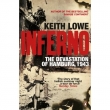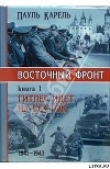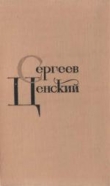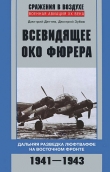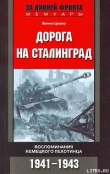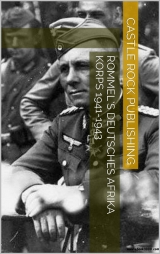
Текст книги "Rommel's Deutsches Afrika Korps 1941-1943"
Автор книги: Автор Неизвестен
Жанры:
История
,сообщить о нарушении
Текущая страница: 14 (всего у книги 19 страниц)

Slowly Battle Groups Liider and Hudel fought their way towards the Medjerda river suffering casualties from the well directed Allied artillery fire, but with every yard gained, threatening to cut the main road. At dusk the protagonists broke off the tank fighting and left the battle to aggressive and violent infantry patrol clashes. Slightly, very slightly, but very certainly the Germans had gained the upper hand and were beginning to win the battle.
During the night of 2/3 December Panzer Grenadier reinforcements arrived for Battle Group Djedeida. The infantry component of this battle group had been too weak to drive the British from their .positions on the ridge above the village and, with no reserve immediately to hand and upon which he could draw, Fischer had airshipped to him from Europe two of the Grenadier Companies of 10th Panzer Division. These had barely arrived upon the battlefield when they were put into action and into an attack upon the British infantry.

The Djedeida Group had been promised Stuka support for their new-drive but this had not materialised by 10:00hrs and so the infantry was committed to the assault without it. [23] The German Grenadiers mounted a two-pronged thrust against Djebel Maiana and had captured this by midday. During the afternoon British counter-attacks came in but these were beaten off and, having regrouped, the German attack was resumed, this time with tanks. The armoured punch smashed through the position held by the Hampshire and cut off part of that battalion. The East Surreys were sent in to restore the situation and carried out a determined assault upon Djebel Maiana but even their elan failed in the storm of defensive fire which the Panzer Grenadiers poured down upon them. Liider Group reached the Djedeida thereby cutting the road to the Tebourba Gap while Battle Group HudeL which had co-operated in the thrust to the river, closed and held tight shut the escape routes to the north and north-west.
The situation for the Allied force in the Tebourba area and, particularly for the infantry battalions of llth Brigade, had become more and more precarious. A withdrawal through the Gap was authorised. The Allied retreat from the village began after dark but was soon caught in the storm of artillery fire which the Germans brought down upon the columns. Lorries, tanks, guns – all were abandoned on the western road upon which the machine guns of Koch's paratroops were also now pouring a rain of bullets and mortar shells in an effort to destroy the Allied convoys. By 3 December there was no doubt that the advantage lay with the Germans and they crowned their success with the capture of Tebourba on 4 December. Just after noon of that day Koch's men met up with the Lüder and Hudel Battle Groups and jointly they pursued the Allies westwards and back along the road to Medjez el Bab.
That it was a German victory there could be no doubt for the Allies had voided the field and had abandoned 55 tanks, 29 pieces of artillery, 300 vehicles, and had lost over 1000 men as prisoners of war. The immediate threat to Tunis was over; now the Germans could begin the extension of their perimeters.
The North-Western Front
The Allied withdrawal continued until a point was reached some 8 miles east of Medjez. In position there was another force of Allied soldiers and the officers of 10th Panzer Division were surprised that this force had made no attempt to resume the advance to Tunis and it was supposed that, either, the Allied group was intended to hold the bridgeheads across the Medjerda river or, alternatively, that the Allies had suffered a more serious setback than had been at first believed. If this latter were the case, then the weakness of the Allies must be exploited and the Axis perimeter enlarged by aggressive action.
The panzer commanders laid their appreciation of the situation and their plans for the resumption of the attack before the Corps commander but on the same evening changes in administration raised the command structure to that of an army and the new Army commander, von Arnim, took up post. The complicated chain of command which had been responsible for so many of the disappointments that Rommel had suffered was reproduced here. Although von Arnim and his 5th Panzer Army would be subordinate to the Commando Supremo, in practice he would have direct dealings with Supreme Commander South. His position vis-a-vis Rommel was never made quite clear and was later to lead to difficulties and to complications. Nehring left his command on 8 December, three days after the arrival of von Arnim.
The leaders of 10th Panzer Divjsion realised that in view of the new administrative changes no decision would be forthcoming that evening and acted on their own initiative and, as they believed in accord, with the principle of General Nehring,
A three-pronged attack was made during the morning of 6 December. One prong made a reconnaissance in force towards Medjez el Bab with the intention of uncovering Allied weaknesses, of testing strengths, and of gaining time to build up the 5th Panzer Army's numbers. A second prong struck at American tanks at El Guessa and such was the pressure that the British Commander-in-Chief, General Anderson, withdrew the American armour to Djebel Bou Aoukaz, and the British llth Brigade to Longstop Gap. The attack was showing every sign of being another success for 10th Panzer Division with the Americans abandoning equipment and vehicles but then the advance was halted on the command of von Arnim. The intelligence officers of 5th Panzer Army had interpreted the slowness of the Allied advance as difficulties in supply and had forecast a resumption of the assault to coincide with one which was likely to go in against Rommel. Von Arnim thereupon gave orders that all operations were to be defensive in character to conserve strength. To meet the anticipated assault a re-organisation was undertaken and boundaries changed. Command of the right flank went to von Broich, of the centre to Fischer's 10th Panzer, and of the southern flank to the Italian Superga Division.
In anticipation of the new attack and with movements halted by the heavy rain which fell between 6 and 9 December, the central Tunisian front entered upon a period of quiet which was only broken by a British offensive to capture Djebel el Ahmera, known as Longstop Hill. This feature remained in German hands until Easter 1943.
The intention of the offensive, to dominate the gap between the Djebel Lanserine and the Medjerda river, had been achieved by 10th Panzer Division's armour while other units from that formation had gone on to seize Bou Djebel Toum. The 334th Division had captured the pass area to the west of Chouigui and the important high ground was then in German hands. To the south of the Tunis bridgehead, Koch's regiment and Superga Division had advanced their positions on both sides of Pont du Fahs.
Thus by the end of the year the Germans had gained their objectives. There was a bridgehead of such depth that it could not be destroyed by a surprise attack. A firm link existed between the forces in the southern half of Tunisia and Rommel's desert army and the military initiative had been seized from the Allies.
This sudden transition from defence to attack was an example of the flexibility of the German military mind as well as a demonstration of the ability of the infantry and the panzer men. But the role of the Luftwaffe during those tense and difficult days and weeks must not be overlooked for it was crucial to the success of the Axis defence and counter-offensive. Indeed it is true to say that the Germans could not have survived the first days of the campaign without the active and vigorous support of the Luftwaffe in attacking, obstructing, and, in some cases, destroying the Allied spearheads. As an example of its activity, during the period from 20 November to 12 December, a daily average of 18 dive-bombing attacks and 25 missions by fighter and fighter-bomber was carried out. During the three days of the 10th Panzer Division counter-attack the number of missions flown was 54 and 108 respectively.
This short-lived superiority in the air enjoyed by the Germans was due in part to the fact that their bases at Tunis and Bizerta were all-weather airports and aircraft could and did operate from them when the Allied airfields were unusable. This all-weather facility and the close proximity of the aerodromes to the combat zone enabled the Luftwaffe to give complete cover and almost immediate support to the troops in the field as well as protection to the machines of transport command which were airlifting men and materials from Sicily. The achievement of that command was that it brought into the bridgehead areas during those first months no less than 7 battalions of infantry, whole batteries of field guns, 2 armoured reconnaissance companies, and at least 19 tanks, of which 4 were the giant Tiger Panzer VI.
German impressions on how the campaign was progressing are interesting for they show how clearly the men in the field anticipated the future turn of events. All ranks from Rommel and von Arnim down to subaltern officers realised that the Allies would seek to separate 5th Panzer Army from 1st German/Italian Panzer Army by an attack from one of the western passes through the mountains, and that the decisive blow would be delivered from the area of Medjez el Bab. It was apparent to all German commanders that Medjez el Bab held the key to the whole campaign and in order both to protect their own bridgehead as well as to deny this key point to the Allies, 5th Panzer Army proposed to seize the town in a pincer operation code-named Olivenernte, The time set for the opening of this offensive was the second half of January and the plan was that 334th Division would strike from the north and meet the pincer of 10th Panzer ascending from the south. To divert Allied attention and to gain important features, other German battalions would capture Djebel Mansour while Superga Division secured the Pichon heights.
To hide from the Allies the fact that 334th Division had left the line to prepare for the forthcoming assault, 'Chinese' attacks were launched in Djebel Chirich area and at other points along the Medjez sector. The Allies however were not inactive and an attack which was launched at Jefna on 6 January involved the German garrison in battles which swayed to and fro for nearly a week until 5th Para were sent in and restored the situation. Down in the deep southern half of the bridgehead the Superga Division, in position east of Djebel Chirich and west of Sbikha, was attacked by a French Corps which was now fighting alongside the Americans. The poor showing of the Italian soldiers in this sensitive area renewed the fear that they could no longer be trusted to defend themselves or their positions and that they could no longer be stationed in an area from which an Allied assault might strike to the sea. German counter-attacks recovered the ground which the Italians had lost but it was clear that given the shortage of infantry from which both Panzer armies were suffering, there could be no forces to undertake Olivenernte. Von Arnim therefore decided to strike at the weakest of the Allied armies and organised an offensive against the French Corps with the code-name Eilbote.
The 334th Division which had by now left the line was selected as the most suitable unit. It was moved by night drives in commandeered and requisitioned vehicles to a sector south-east of Pont du Fahs. The gap, which had been created by the removal of this division from the battle line, could only be plugged by shortening the line and a number of tactical withdrawals from mountain crests was undertaken and had been completed by 17 January.
Eilbote began on the following day and achieved immediate and important successes. The 334th Division captured the pass east of Djebel Mansour and the heights at Djebel Chirich while the motor cycle battalion of 10th Panzer Division seized Djebel bou Daboussa. The Allies moved back under this pressure and the whole Axis line moved forward to occupy the ground. British counter-attacks around Bou Arada began on 21st and for days there was bitter fighting for high ground but then the northern arm of the German assault, coming through the Chirich pass, linked with a mixed German/Italian group on Djebel bou Daboussa. This sector was now dominated by the Axis troops holding the high ground and the Allies withdrew from it on 24 January. But the strain of battle in the mountains and in the terrible weather began to tell upon the Axis troops who had fought for six days without rest or reinforcement, and they no longer had the determination or the strength to achieve new objectives. Eilbote was called off but the results were satisfactory: the high ground between Pichon and Pont du Fahs was in Axis hands, the immediate threat to the southern half of the Tunis bridgehead had been averted, and the French Corps had been badly hit.
Successful French counter-attacks against the Italians revived the fears that these would not stand their ground. When one particularly severe counterattack around Djebel Chirich forced a German unit to fall back east of the gap the 5th Panzer Army commanders saw a chance to counter-attack, to outflank, and then to roll up the French line. They mounted a second Eilbote operation on 1 February. Tiger tanks of 501 Panzer Detachment, extra infantry, and increased artillery were posted to the assaulting units and, with this added strength, advances were made along the Pont du Fahs—Rebaa ad Yahia road. The French had by this time been reinforced with American equipment and men so that heavy fighting developed but the German forces went on to capture high ground on the right flank of the attack. There was less success on the inner left wing south of Djebel Chirich where the advance had to be made across open country dominated by American and French artillery of all calibres. Under the barrage of defensive fire the German attack in this area faltered and then halted. On the extreme left flank, however, Pichon fell to 47th Infantry Regiment and Ousseltia was captured by a storm troop detachment. Allied strength grew daily and the resistance which the Germans were meeting compelled them to break off the battle. The Axis wave receded as their troops gave ground and withdrew to strong defensive positions on the heights to the east of the Ousseltia valley.
The far southern extent of 5th Panzer Army's territory was an area in which there had been little fighting, for neither side had been strong enough to force a decision there, but in the second half of January, von Arnim at last had the opportunity to carry out an operation which would secure his links with Rommel's force. German positions to the east of the Faid pass, which had been lost in December, could be outflanked by any French debouchment aimed towards Sfax. Were this to happen then the rupture of the Axis front would have been brought about. As the other sectors of 5th Panzer Army front were relatively dormant there was an opportunity to carry out an operation against and to seize the Paid pass and to hold it as a barrier against the Allies.
To carry out this operation the 21st Panzer Division which was refitting at Mahares was placed under command of 5th Panzer Army and despatched to Paid. The battle plan was simple. Four battle groups would take part. One, with a holding role would attack from the east and under cover of this assault a second group would scale the height of Djebel Kralif. A third force would hold the Rebaou pass while a fourth column cut through the Maizila pass to block any flow of reinforcements to the Paid garrison and also to attack those troops from the west. On 30 January the battle groups struck and the storm troops on the heights of Djebel Kralif descended upon the northern flank of the French positions.
By nightfall it was over and the pass had been seized, but the Americans were not content to let so tactically important a feature be lost so lightly and 1st Armoured Division sent forward two armoured columns to attack the Rebaou and the Paid passes. The group which struck at the Rebaou pass penetrated some distance inside it but was then repelled. A column of infantry, artillery, and tanks commanded by Colonel Stark which charged into the Paid pass struck against experienced panzer men who had had time to prepare their defences.
An artillery barrage halted the American advance and then the Stukas went in to break up the cohesion. One company of 1st Armoured Regiment was drawn to within range of an anti-tank gun line and lost 9 tanks. The United States forces withdrew but came in again on 2 February against the Rebaou pass and this time using infantry ahead of the armour. But this assault, too, failed and the combat command went over to the defence in that sector. On other sectors, too, the American advance had halted and the troops of 1st Armoured Division began to move back upon Gafsa.
Plans had been made to attack Pichon and these were quite far advanced when intelligence reports indicated a strong build-up of American forces in the Sheitla-Tebessa-Sidi bou Zid sectors. This could only mean that an attack would be launched against the German troops in those sectors and that this would probably be made in conjunction with an expected British offensive at Mareth.
Arnim then decided to attack the American force in the Sbeitla sector before it had grown too large and if this move met with success then to exploit it by rolling up the Allied front from south to north. If he could compel the Allies to evacuate Medjez el Bab then the strategic aims for which the Germans had been striving since November and of which operation Olivenernte had been the most recent plan, might yet be achieved.
There were certain temporary difficulties. Fischer, an experienced and forceful tank commander, was killed in action while on a reconnaissance and his death resulted in a general reshuffle of senior posts. The loss of Fischer meant that the new commander would have to 'work' himself into the post and in view of the shortage of time von Arnim called off that attack and concentrated instead upon the objective of Sidi bou Zid.
Fischer's death and the difficulties which this caused can serve to illustrate at this point one weakness of the German command structure in Tunisia. From the first days there had been no adequate staff organisation and no staff officers at all. Most divisions reaching Africa were not complete formations but usually individual regiments, and, of course, were without divisional hierarchy. It can be appreciated that staff officers, even of quite junior rank were seized upon to fill empty staff appointments at fairly senior levels. Thus there was no Corps structure because there were insufficient numbers of efficiently trained officers and 5th Panzer Army formed ad hoc groupings and then called these Corps, although they seldom had the strength of even a division on the continental mainland. Only the length of front which such units had to hold, the tasks given them to perform, and the requirements of command structure led to these groupings being called Corps.
The Tunisian Bridgehead
In the last days of January to the accompaniment of icy winds and in bitter cold the advanced guards and then the main of Panzer Army Africa crossed the frontier into Tunisia and by 12 February, the second anniversary of the German arrival in the African theatre of operations, those Axis positions still on the soil of Tripolitania were also withdrawn into the bridgehead area. Here in this fertile country the desert veterans of the years of 1941 and 1942 returned to a European-type warfare in which the infantry arm carried the main burden of battle.
The 1st German/Italian Panzer Army was ordered to stand on a position at Mareth which had first been constructed and then destroyed by the French. At the high echelons of command in Rome and Berlin it was perhaps believed that the Mareth line was strong and well fortified; but this was not the case. The whole position was badly sited and quite-weak. Immediately in front of the main defensive position a ridge dominated the Axis positions and to garrison this took men from the battle line. In the south the flank was wide open and the gap between Djebel Ksour and the coast required a strong garrison to protect the over-long western-flank against an outflanking movement. Then too, the Allied presence in Gafsa required that intensive and heavy patrols be maintained in the area of the Djerid Schott.The French had constructed this weak line against the Italians in Tripoli and had left the western flank open for it would have been from Algeria and Tunisia that their reserves would have come. But to the Axis commanders the passes leading from the interior of Tunisia and debouching on to the coastal plains were a constant source of worry because it would be out of these passes that the attack might come which would sever 5th Panzer Army from 1st German/ Italian Army. Every one of these passes lay behind the troops who were defending the Mareth position, and they would be a threat until the Enfida-ville line was taken up. But that is to anticipate because the Mareth Line was ordered to be held to the last.
The whole line was a geographical and not a military position and certainly not one which any soldier would have chosen to defend nor risked men trying to hold.
Rommel was disappointed but not surprised to find that the arms and fuel had not arrived as Hitler had promised they would. So little had been received that there was no barbed wire and only a small number of anti-tank mines. Once again his army would have to make do: the men, turning to obsolete and, in some cases, obsolescent weapons, and depending upon the fighting spirit of those whose time spent in the front line was now being measured in weeks and not in days.
Rommel deployed the Italian XX Corps and 90th Light Division to hold the main battle line and placed in reserve the 15th Panzer and 90th (Africa) Divisions. The east—west passes at Kieddache and Halouf were blocked by 164th Division. In support of the thin infantry and panzer line there were 65 German and 340 Italian field guns. There were also 36 batteries of Italian anti-aircraft guns; 18 light and 18 heavy, while among the 12 batteries of German 8.8cm flak were 2 batteries fitted out with guns of the new, improved 1941 pattern. Another defensive grouping was made up from 10 batteries from 19th Flak Division.
There were, however, grave and serious shortages of infantry. The 90th Light Division had had such losses that regiments had been reduced to an average strength of 350 bayonets and the whole division was almost completely defenceless against armoured attack for most of its anti-tank guns had been lost and not replaced.
The total artillery fire-power of 164th Infantry Division was a single battery of field guns, for it was anticipated that the German infantry would be able to sustain a defence in the mountains with only minimum support. The most dangerous military risks were being taken and there were sectors which were covered only by patrols.
On 28 January, Commando Supremo, fearful of an attack to the sea by American forces which were being assembled in the Tebessa area and conscious of a similar threat posed in the Gafsa area, ordered that an offensive be launched to seize and to hold the western passes,
Kesselring's orders to Rommel were to attack and destroy the American forward line and once the
United States forces had been driven back on Sbeitla and Feriana, then Sidi bou Zid could be taken and the Gafsa and Touzeur sectors could be seized. To carry out his part of the plan von Arnim's army, with two panzer divisions under command, would strike for Sidi bou Zid in an operation code-named Frithlingswind, while 1st German/Italian Panzer Army, in its operation Morgenluft, would drive to secure the west and the north-westerly flanks and then return its armoured units back to the Mareth front. The Luftwaffe Brigade would be used to garrison the captured areas.
There were deep and fundamental differences between Rommel and von Arnim as to their respective strategies for the forthcoming operations. Von Arnim, with his cautious approach considered that his task was to hold the bridgehead for the longest possible time and, not wishing to risk his forces, intended to launch only large-scale spoiling attacks. Rommel, with his greater flair for far-flung battles grasped the opportunities which such an operation presented.
By combining the Axis forces the western passes could be captured and then in a massive punch the Allied front could be smashed open. Through the breach would flood the armoured divisions aiming for Tebessa and then for Souk el Arba, deep behind the front of the Allies' 1st Army. Faced with this thrust in the back the Allies would have to give ground and withdraw to Algeria. The Axis bridgehead in Tunisia would, therefore, have been enlarged.
Von Arnim could not agree to Rommel's bold plan and both commanders appealed for Kesselring's decision. Mussolini's order, transmitted through Kesselring as Supreme Commander South, was a dilution of Rommel's plan for the objective was not to be towards Tebessa and Souk el Arba but towards Le Kef, a road junction immediately behind the Americans. Rommel argued that it would be at Le Kef that the Allied commander would have his strong reserve forces, and that, in any case, a successful advance upon Le Kef would achieve only a tactical and not a strategic victory, nor would it lead to a collapse of the Allied front in Tunisia, nor to the withdrawal of Allied forces which Rommel had planned.
Thus the die was cast. The two independent operations had as their intention the seizure of the western passes with Paid as the first objective and with this in Axis hands then the drive towards the Kasserine pass. Then would follow the attack against Gafsa and if this were successful then the sensitive south-western flank of the Tunisian bridgehead would have been secured, and the threat to the desert army holding the Mareth line would have been annulled.
The 10th Panzer, one of the two armoured divisions which von Arnim was to use in operation Fruhlingswind, moved through the streets of Tunis in the dark and cold days of early February and arrived in positions south-west of Kairouan. By now the men of the German panzer divisions had learned the need for correct camouflage and had dispersed their vehicles under nets among the cacti which grew profusely in the area. The infantry was dug in for better concealment in the sides of wadis which crossed the region and the division prepared itself for action. Ration and supply points were built for armoured actions, for particularly when these were fought at night, easily locatable dumps were required at which the tanks could refuel and rearm before returning to battle. It had become standard practice for extra drums of fuel to be carried on the outside of the tanks, despite the fire risk, to increase the length of time that the vehicle could stay in action. So that the tanks did not have to return for extra ammunition it had become usual for an additional box of armour piercing shells to be carried inside the tank.
In the workshops of each panzer company fitters carried out the final adjustments and minor repairs. Sand and dust which had clogged the air filters were cleared out. The dust which penetrated into every crack of the machinery reduced the life of the engine and the standard filters, originally fitted to the outside of the tank, had proved ineffective. These had, therefore, been enlarged and placed inside the vehicle. The increased life of the motor, which this refitting produced, was offset by the disadvantage that the interior of the machine was quickly covered with sand which affected the gun and its ammunition. Even the gun muzzle had to be fitted with a cloth to protect the
inside of the barrel from the scouring effect of the sand.
During the night of 10 February the division moved southwards to an area 25 miles east of Paid and the vehicles went, as matter of routine, into the olive groves which bordered the road. These orchards were ideal ambush positions for the trees were tall enough to hide a tank from the gaze of an enemy commander standing in his tank turret.
Reconnaissance on llth showed that there was no organised American opposition in the area around Paid. In the evening of 13 February the assault troops of 10th Panzer moved forward to the forming-up area, an olive grove eight miles east of Paid, where the attack orders were given out.
Ziegler, the commander of this operation and whose task it was to coordinate the assaults of the two panzer divisions, had already carried out his own personal reconnaissance and had drawn up his battle plan. The 10th Panzer was to form three battle groups and was to send two of these armoured forces through the Paid pass while the third remained in reserve. The non-motorised units of 21st Panzer which had been in position near Paid since the end of January would attack from the village under an artillery barrage and exit from the Rebaou pass to strike towards Sidi bou Zid. Meanwhile armoured elements of 21st Panzer would penetrate the Maizila pass and upon exiting would divide into two battle groups. The Schuette Group would advance northward to approach Sidi bou Zid from the southwest, while Stenkhoff Battle Group would move on Sidi bou Zid via the Bir el Hafey Road.
Shortly after I0th Panzer Division had arrived in its forming-up area, the General Officer Commanding issued his orders and laid down the composition of the forces which would fight the battle. Reiman Battle Group would attack along the Faid-Sbeitla road and capture the Poste de Lessouda and for the assault it would have under command 2nd Battalion 86th Panzer Grenadier Regiment, 5 Tiger tanks of 501st Tank Battalion, a platoon of the Panzer Engineer Battalion, an assault battery of 4 10.5cm guns, and 2 platoons of SP anti-tank guns.


